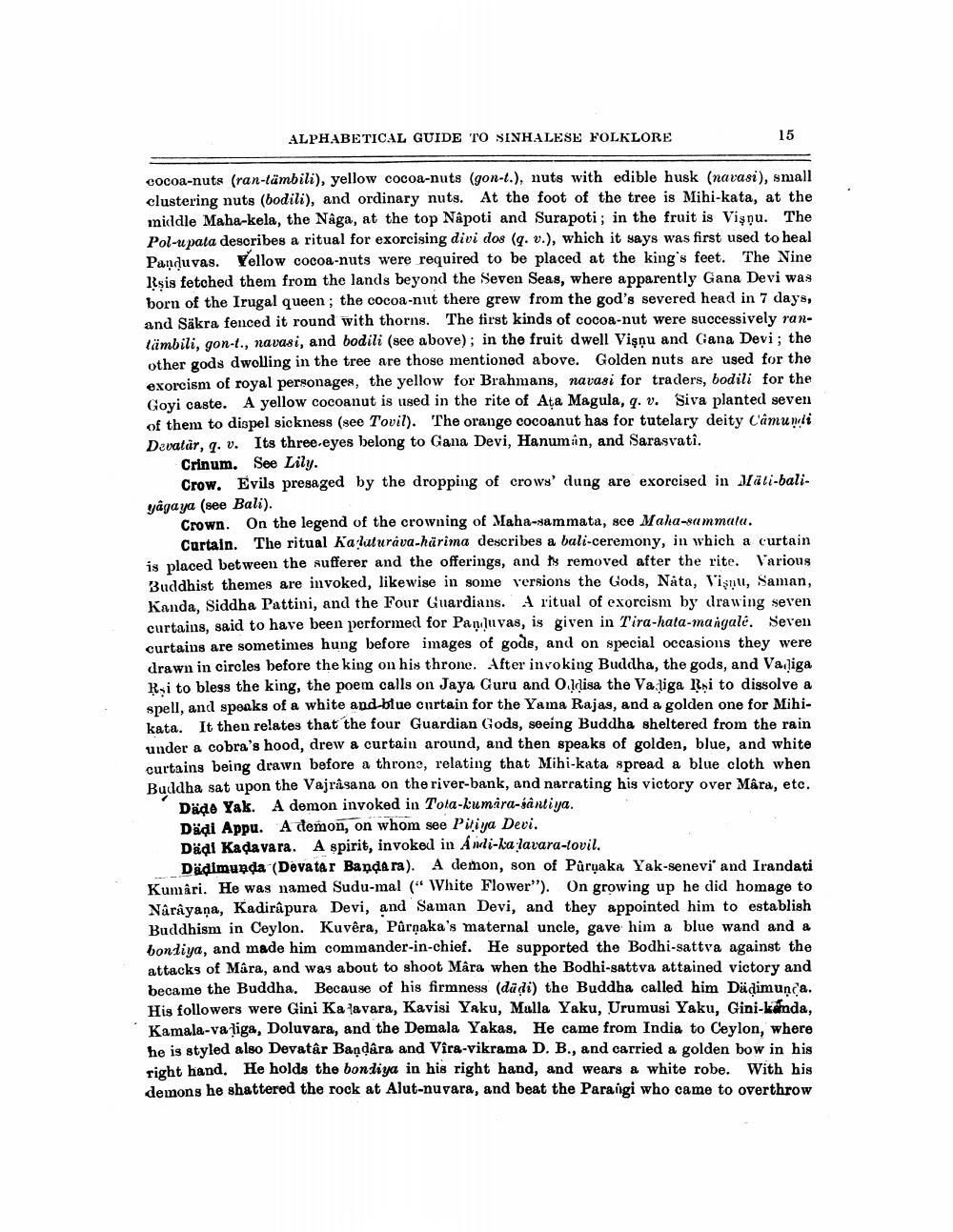________________
ALPHABETICAL GUIDE TO SINHALESE FOLKLORE
15
cocoa-nuts (ran-lämbili), yellow cocoa-nuts (gon-t.), nuts with edible husk (navasi), small clustering nuts (bodili), and ordinary nuts. At the foot of the tree is Mihi-kata, at the middle Maha-kela, the Naga, at the top Nâpoti and Surapoti; in the fruit is Vişnu. The Pol-u pata desoribes a ritual for exorcising divi dos (q. v.), which it says was first used to heal Panduvas. Yellow cocoa-nuts were required to be placed at the king's feet. The Nine Rsis fetched them from the lands beyond the Seven Seas, where apparently Gana Devi was born of the Irugal queen; the cocoa-nut there grew from the god's severed head in 7 days, and Säkra fenced it round with thorns. The first kinds of cocoa-nut were successively rantämbili, gon-t., navasi, and bodili (see above); in the fruit dwell Vişnu and Cana Devi, the other gods dwolling in the tree are those mentioned above. Golden nuts are used for the exorcism of royal personages, the yellow for Brahmans, navasi for traders, bodili for the Goyi caste. A yellow cocoanut is used in the rite of Ata Magula, q. v. Siva planted seven of them to dispel sickness (see Tovil). The orange cocoanut has for tutelary deity Camuni Devatar, q. v. Its three-eyes belong to Gana Devi, Hanumin, and Sarasvati.
Crinum. See Lily.
Crow. Evils presaged by the dropping of crowy' dung are exorcised in Jäli-baliyâgaya (see Bali).
Crown. On the legend of the crowning of Maha-sammata, see Maha-ammata.
Curtain. The ritual Kaluturava-härima describes a bali-ceremony, in which a curtain is placed between the sufferer and the offerings, and I removed after the rite. Various Buddhist themes are invoked, likewise in some versions the Gods, Nata, Vishul, Saman, Kanda, Siddha Pattini, and the Four Guardians. A ritual of exorcism by drawing seven curtains, said to have been performed for Panduvas, is given in Tira-hala-mangale. Seven curtains are sometimes hung before images of gods, and on special occasions they were drawn in circles before the king on his throne. After invoking Buddha, the gods, and Valiga Rsi to bless the king, the poem calls on Jaya Guru and Oldisa the Va.liga Rxi to dissolve a spell, and speaks of a white and blue curtain for the Yama Rajas, and a golden one for Mihikata. It then relates that the four Guardian Gods, seeing Buddha sheltered from the rain under a cobra's hood, drew a curtain around, and then speaks of golden, blue, and white curtains being drawn before a throne, relating that Mihi-kata spread a blue cloth when Buddha sat upon the Vajrâsana on the river-bank, and narrating his victory over Mâra, etc.
Dado Yak. A demon invoked in Tota-kumara-sântiya. Dädi Appu. A demon, on whom see Piriya Devi. Däal Kadavara. A spirit, invoked in Amli-ka lavara-lovil.
Dädimunda (Dovatar Banda ra). A demon, son of Půrụaka Yak-senevi' and Irandati Kumari. He was named Sudu-mal (" White Flower"). On growing up he did homage to Narayana, Kadirâ pura Devi, and Saman Devi, and they appointed him to establish Buddhism in Ceylon. Kuvêra, Pärnaka's maternal uncle, gave him a blue wand and a bondiya, and made him commander-in-chief. He supported the Bodhi-sattva against the attacks of Mara, and was about to shoot Mâra when the Bodhi-sattva attained victory and became the Buddha. Because of his firmness (dädi) the Buddha called him Dädimunca. His followers were Gini Ka Javara, Kavisi Yaku, Malla Yaku, Urumusi Yaku. Gini-kanda. Kamala-va liga, Doluvara, and the Demala Yakas. He came from India to Ceylon, where he is styled also Devatêr Bandara and Vira-vikrama D. B., and carried a golden bow in his right hand. He holds the bondiya in his right hand, and wears a white robe. With his demons he shattered the rock at Alut-nuvara, and beat the Parangi who came to overthrow




